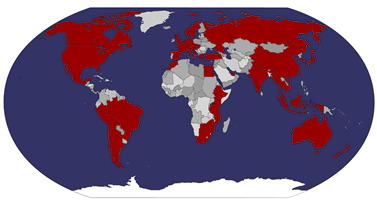
Kadam Station
Security at the station ask to check my bags, but when they see the effort involved in going through my pack, they just wave me through.

Standing on the passenger footbridge

Snow-capped mountains above Damascus
The night sleeper train from Aleppo arrives as I cross the frost-covered bridge to the platform where my modern French train awaits.

My train
On the train I have an issue -

Which toy to play with..
My ticket is entirely in Arabic so I haven’t a clue which carriage or seat number, but the conductor soon puts me right, and, like so many others, warmly welcomes me to Syria.

That would be seat number…err…
For no obvious reason before departing we’re moved one carriage along. The sun is just coming up, but this carriage is much colder than the last! First class is relatively empty.

According to my watch we actually leave a minute early, though I’ve had so many interpretations of the departure time, I can’t be sure. We head north, stopping at some minor stations. I work out why there’s not much rubbish in Damascus – we had remarked how clean it seemed. That’s because the bring it all out here and dump it nearby the railway lines. We’re served tea and coffee, and issued with headphones for the in-seat (audio) entertainment – I told you this train was modern!

Not always much to look at out the window
We pass through Homs, Syria’s third largest city, which looks as dreary and industrial as LP implies. The journey seems to be taking longer than I expected – I thought from the timetables on the marvellous http://www.seat61.com that it would be about two hours, but it ends up being about three. As we approach Hama, we pass some enormous power stations, but they’re far enough away thankfully. The ground seems to be getting more watery, which figures as Hama is famous for water-wheels of some kind. It starts to rain! More Syrian generosity – that chap sitting a couple of rows behind me who I keep asking whether it’s my station yet goes to the buffet car and buys me some orange juice!
Hama and its Enormous Station
At Hama, which means fortress and is in Central Syria, I alight into an almost deserted but enormous grand station. It’s so disproportionate to the traffic it serves – I think I might have been the only person who alighted! I try to get some train times off the staff there, but it’s like pulling teeth so I give up and go to look for a taxi. Unsurprisingly, there are none, so I end up walking towards where I think town is, and luckily it isn’t long before an empty taxi passes and stops. 50 pounds (indicated by showing five fingers, it’s a good job I knew ballpark how much it should cost) and I was whisked into town to the LP recommended Riad Hotel. Incidentally I notice that the second and third choice hotels are both adjacent, so it won’t be hard to find somewhere if Riad is full.
Upstairs at reception, I met Abdullah, who is really friendly and helpful, and sorts me out with a small but clean room in no time. 350 pounds per night, far more in-line with my budget than Al-Famia in Damascus! Later I read the guest books, and everyone staying here raves about Abdullah and how he goes out of his way to be helpful – hence why apparently they had a full house yesterday despite it being low season now. He invites me to have tea and we chat.
Next I head out, and grab something to eat at Ali Baba’s, a cheap restaurant a few doors along. I have the “Moutabal Meal”, which consists of a couple of wraps which are dumped on to the table in front of me – this seems to be what they do with everyone, and then a few trays of things – a bowl of salad, and a plate of moutabal.

Ali Baba’s Restaurant
It’s nice, and for 40 pounds who can complain? This finished, I walk down to the river, not far away, where I encounter my first water-wheel.
Norias, or the Famous Water-Wheels of Hama
Now I wasn’t really sure what to expect from these wheels, which are called “norias”. There are 16 of them dotted along the Orontes river. I imagined something like a water-mill like you’d see in some sort of restored heritage thing in the UK. What they actually have though is a ramshackle enormous wooden thing looking like a ferris wheel gone wrong, and the aspect which invites incredulity above all else is the noise – there doesn’t appear to be any lubrication, so as the thing turns at a very irregular speed, sometimes stopping, speeding up etc, it makes a noise like the world’s largest wooden door being open and shut repeatedly, a loud creaking groaning moaning sound which is absolutely unique.

Historically they were used for irrigation, for lifting up water which would then run along aquaducts to the gardens, but today they are purely a tourist attraction.


Further along, one finds four in two pairs called Four Norias of Bechyyriyyat, one pair on either side of the river. Some of them are being restored at the moment, and have a crowd of people banging away with hammers and introducing new wood where required.


I then make the big mistake of continuing round the riverbank on the mud. There was something about the red mud, the stickiest mud I’ve ever walked on. Within minutes I had huge piles of the sticky muck hanging off all sides of my sandals, which I am wearing with socks! I later learn Rob had the same issue. He, though, was wearing hiking boots.

I try to scrape some off, but there’s so much of it. I spent the next twenty minutes scraping my sandals on every edge I can find, and leave a trail of muddy prints wherever I walk.

At the end, I find the largest wheel of all (21m diameter), Al-Mohammediyya, which was built in 763 AH (1361CE).

I can only assume these dates mean 1361 AD, or 763 years past something to do with the Prophet Mohammed.

Sluice Gates

And the dirty water flowing through them
From here I loop round the other side of the citadel, passing shops and local areas, and several mosques. People say hello more here than in Damascus, I guess it’s a smaller town (but contrary to what LP says, it does have ATMs, thank goodness. After all, it’s supposed to have 1.5 million people living here, though you’d never guess it from the feel of the place).

Touches of India here..


Back at Riad, I meet a Korean chap who is married to an Uzbek. When I ask him more about this apparently strange arrangement, he tells me that many Koreans used to live in the Manchurian area of China, and suspicious that they would sell out Russia to the Japanese, Russia apparently moved hundreds of thousands of Koreans to Central Asia – his wife’s father was one of these enforced migrants. Anyway, this chap has travelled almost all of the Silk Route, with two countries on his exception list – Iraq, for fairly obvious reasons currently, and Saudi Arabia, who have refused him a visa. I didn’t know this, but you have to have a reason or invitation to go to Saudi Arabia, and tourism is not an acceptable one. Plus of course the “rule” is that Mecca and Medina are off-limits to non-Muslims, which will always be a big gripe of mine until it’s lifted, which I doubt it ever will be.
Hanging out in the lounge, my friends Rob and Annette turn up. We arrange to have dinner again. Meeting at 7pm, we venture out to Aspasia restaurant, near the river.

It’s a similar format to last night, a smart restaurant in a large pretty courtyard, the food good-quality “Lebanese” style food.

No beer again, but we make up for this by stopping at the bottle shop on the way back. The evening ends in the restaurant in Riad Hotel, with a Korean pair, Swedish chap and a Japanese guy. We only get told off for making too much noise once! Was inevitable really, with Aussies and Koreans mixed with alcohol!
Incidentally, according to wiki, political insurgency by Islamic groups in the early 1980s culminated in an uprising in February, 1982. Government forces led by the president's brutal brother, Rifaat al-Assad, quelled the revolt, but murdered thousands and destroyed much of the old part of the city in the process. The town was shelled by the Syrian military, and the estimated deaths numbered more than 20,000 and may have been as high as 30,000 or 40,000, a big portion of them were women and children. The story is suppressed in Syria.




2 comments:
are you nearly home??!!
Yes, anonymous poster, I am nearly home.
Post a Comment